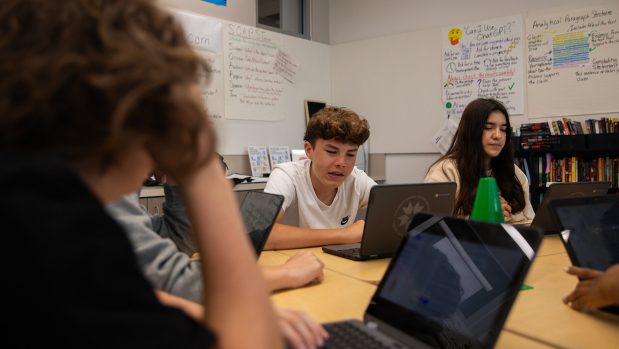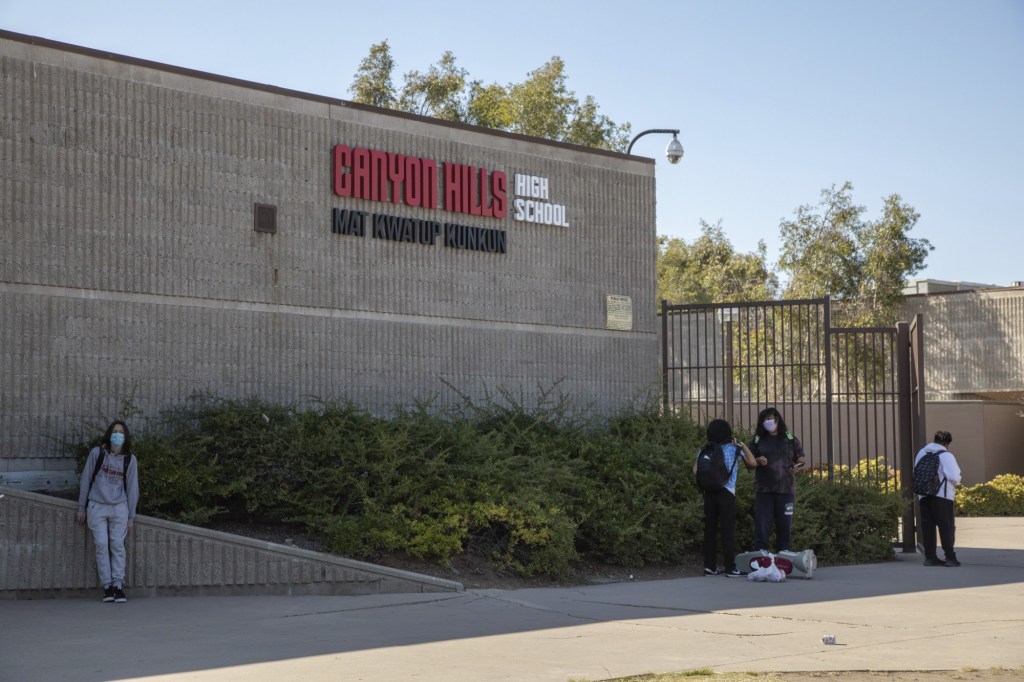Proposed changes to class schedules at San Diego Unified high schools that have triggered pushback from families and teachers could finally get voted on this week.
The district wants to move more of its schools to what’s known as a 4×4 block schedule — four periods each day, rather than six classes per day that last all year.
A number of the district’s high schools, including its magnet schools, already use some form of 4×4 schedules. Three more — Mira Mesa High, Madison High and Canyon Hills High — could get such block schedules if the change is approved.
Those three are considering a 4×4 hybrid schedule where some classes — for instance, an Advanced Placement course — might be yearlong.
“These three schools in particular have already done a lot of engagement — not just with their staff, but with their students and their families — around the 4×4 model,” said Nicole DeWitt, the district’s deputy superintendent.
Some parents worry the change could hurt students by giving them less time overall in each class. But there’s scant research on the issue, and one local researcher sees a benefit in longer class periods for deeper learning.
A plan that would have seen different schools trying out the schedule was first presented at a board meeting late last month where some teachers and parents, many from Point Loma High School, spoke out against it.
But after confusion about the plan from trustees, administrators and members of the public, a vote was delayed. Now an updated version with just three schools is set for Tuesday’s school board meeting.
Why is the district considering this?
High school students have to meet a lot of criteria to graduate.
Most students are also working toward a diploma that includes all of the A-G requirements to get into any public university in California. San Diego Unified now requires students to take ethnic studies before they graduate. And in just a few years, the state will begin requiring a class on economic literacy.
Board trustees say they’ve heard from families concerned that students can’t fit all the classes they want to take into the schedule. Board President Cody Petterson shared his own family’s experience — even his middle schooler, still years away from high school, worries she won’t be able to fit in all four Latin classes she wants to take.
“I’ve got a lot of pressure from my own experience in the last three years, in terms of, we need more classes,” he said.
More classes would also allow more opportunities for students to take remedial or make-up classes without getting off-track.
DeWitt said district leaders will make their case Tuesday by pointing to their goals for students — such as completing dual enrollment, completing A-G requirements with a grade of C or better and completing a college, career and technical education pathway with a C or better.
“That’s really what we’re trying to focus on,” she said. “How do you strategically schedule students so that they can meet not just one college and career indicator but multiple? Because we want our students to be prepared for whatever might lie ahead.”
Under the current six-period day, DeWitt said students don’t really have flexibility until their junior or senior year. Many students who need the most support, especially English learners and those receiving special education services, have even less flexibility.
What does the research show?
Research around schedule changes is largely decades-old. But there’s also very little research that suggests one type of schedule has significant advantages over another.
“Besides the little research that exists, there’s really inconclusive results,” said Hannah Cooke, a recent doctoral graduate from the University of Connecticut’s Neag School of Education who has studied block schedules.
The biggest issue with semester schedules, she said, is that many standardized tests are administered in the spring — which could mean a long gap between fall classes and spring tests on that material.
 Students read during Jen Roberts’ English class at Point Loma High School in San Diego on May 3, 2024. Parents and teachers from Point Loma High spoke out against a possible class schedule change recently. (Photo by Adriana Heldiz, CalMatters)
Students read during Jen Roberts’ English class at Point Loma High School in San Diego on May 3, 2024. Parents and teachers from Point Loma High spoke out against a possible class schedule change recently. (Photo by Adriana Heldiz, CalMatters)
“It just depends on how much we want to think about standardized testing in our decisions about school scheduling,” she said.
But one benefit of such block scheduling is having more classes, which has made it especially popular in states like her own that have more demanding graduation requirements, she said.
“I’ve heard from a lot of teachers that it’s really hard to meet all these mandates and then also allow students to choose,” she said. “If they do band, they’re not going to do any other electives.”
Sarah Fine, a professor of education at UC San Diego, said there’s been a trend toward 4×4 schedules not just in California but nationwide.
One driver is the growing popularity of dual-enrollment classes offered with local colleges, and the fact that the block schedule format already dominates higher education.
In California, another driver is the A-G requirements, and schools’ emphasis on ensuring students achieve those.
Fine acknowledges that some concepts and ideas that can take more time for students to absorb may benefit from a yearlong schedule.
But based on her qualitative research, she believes in block scheduling for adolescents. Dividing learning into small blocks, with students moving around constantly and teachers seeing more than 100 kids over the course of a day, isn’t good for anyone, she said.
“It’s really choppy,” she said. “It does not allow for depth. It does not allow for inquiry and active learning in the same kind of ways. It doesn’t allow for deep relationship building or continuity.”
Whether they’re teaching hourlong or 90-minute classes, Fine said, teachers need to be thinking about designing for active learning, and subdividing their class time to keep students engaged.
“The main things that are happening in classrooms involve kids actually making sense of what’s happening — like being engaged in inquiry, working together, solving problems, doing labs,” she said.
What do families and teachers think?
At one board meeting late last month, the public reaction was largely negative. Many of the commenters — both parents and teachers — were affiliated with Point Loma High School, a generally high-achieving school, and said a 4×4 schedule would not work for them.
Karoly Tippets-Russell, an educator at Point Loma who also has two children there, said the change would cut the total hours students spend in each class. And she downplayed the significance of one cited benefit — the chance it affords for students to retake classes they fail.
“This may be an issue at some schools, but Point Loma High only has a 5% failure rate as of our last reading period, so we don’t need this benefit,” she said. “What our students do need is instructional minutes in the classroom.”
Point Loma parent Lori Williams, an instructional coordinator at another school, spoke in support of the change. Her experience, she said, has been that block scheduling helps students experience more labs and work-based learning opportunities.
“My son last year was in an honors chemistry class. He had on average one lab a month — whereas at the 4×4 school, students had on average four labs a week,” she said.
As for teachers, last month union leaders raised concerns that the board’s method of telling schools what their schedules would be went against the spirit of the union contract.
“The board is voting on a top-down approach to implementing block schedules that runs counter to our shared goal of advancing democracy in our schools,” said Kyle Weinberg, president of the San Diego Educators Association. “We can do better.”
 Teachers union leader Kyle Weinberg, pictured at a press conference in February, pushed back at a San Diego Unified board meeting last month on proposed class schedule changes. (Alejandro Tamayo / The San Diego Union-Tribune)
Teachers union leader Kyle Weinberg, pictured at a press conference in February, pushed back at a San Diego Unified board meeting last month on proposed class schedule changes. (Alejandro Tamayo / The San Diego Union-Tribune)
He said the union’s bargaining team had previously proposed stronger protections around moving to block schedules and had not gotten a response from the district. DeWitt said they are in active bargaining.
Fine, the UCSD researcher, cautioned that when schools shift to new schedules, teachers can’t just “plug and play” their old lesson plans into new periods and need support from their districts.
“One pitfall for administrators and for the district offices is to really make sure they’re not just assuming they can make this change without commensurate investments in teacher learning,” she said.
What happens next?
If trustees approve the plan Tuesday, Mira Mesa High, Madison High and Canyon Hills High would move to a 4×4 hybrid schedule — a mix of semester and yearlong courses — next year. How long each class runs would depend on how a school sets up its schedule.
They would be given professional learning and collaboration on lesson design, DeWitt said. That and other work, including on engagement, would happen this school year to set up for launch next school year.
The district will also collect data, before and after, on student outcomes and on college and career readiness indicators. The hope is that the data will help not just the board but other schools considering whether a 4×4 schedule might work for them too, DeWitt said.

